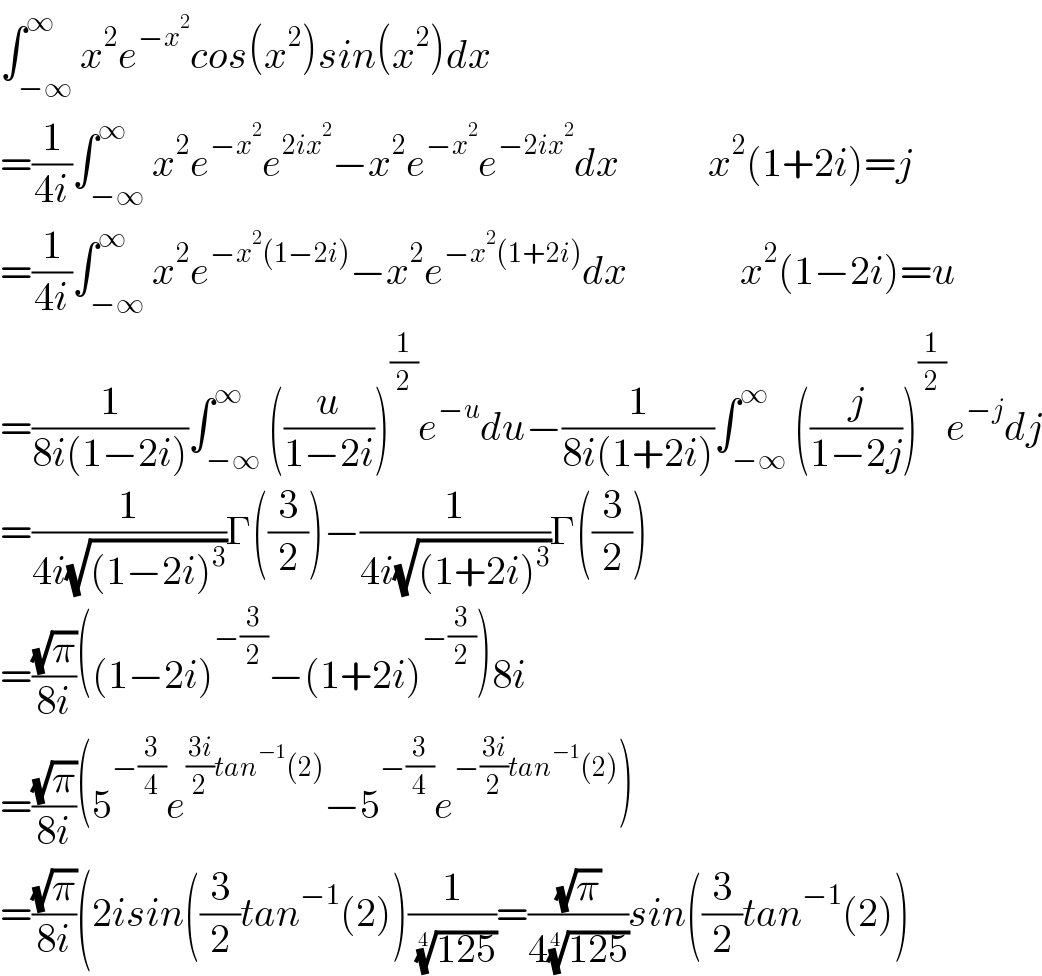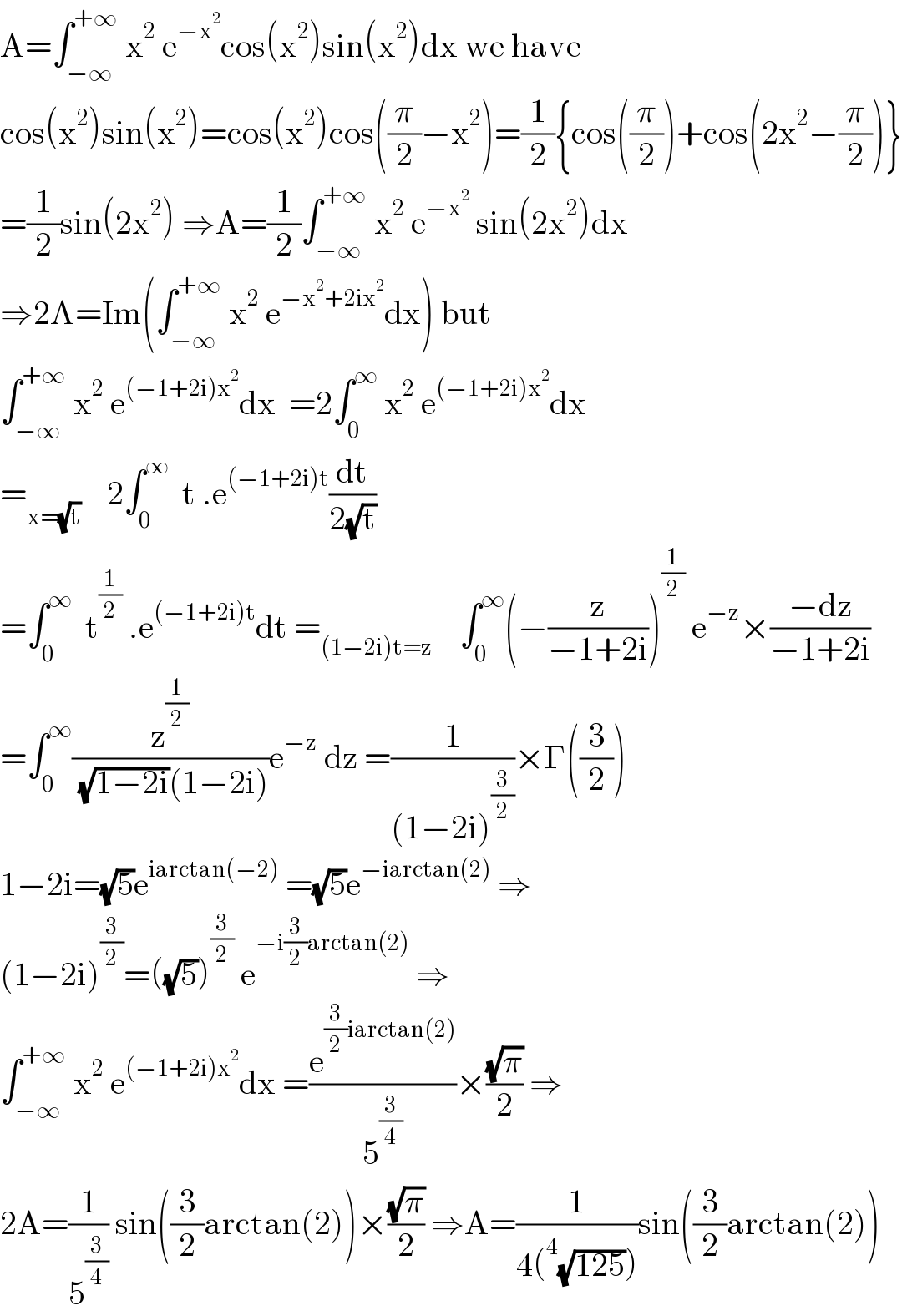Question Number 129764 by Eric002 last updated on 18/Jan/21
![prove that ∫_(−∞) ^(+∞) x^2 e^(−x^2 ) cos(x^2 )sin(x^2 ) dx =(((√π)sin[(((√3)tan^(−1) (2))/2)])/(4 ((125))^(1/4) ))](https://www.tinkutara.com/question/Q129764.png)
$${prove}\:{that} \\ $$$$\int_{−\infty} ^{+\infty} {x}^{\mathrm{2}} \:{e}^{−{x}^{\mathrm{2}} } \:{cos}\left({x}^{\mathrm{2}} \right){sin}\left({x}^{\mathrm{2}} \right)\:{dx} \\ $$$$=\frac{\sqrt{\pi}{sin}\left[\frac{\sqrt{\mathrm{3}}{tan}^{−\mathrm{1}} \left(\mathrm{2}\right)}{\mathrm{2}}\right]}{\mathrm{4}\:\sqrt[{\mathrm{4}}]{\mathrm{125}}} \\ $$
Answered by Dwaipayan Shikari last updated on 18/Jan/21

$$\int_{−\infty} ^{\infty} {x}^{\mathrm{2}} {e}^{−{x}^{\mathrm{2}} } {cos}\left({x}^{\mathrm{2}} \right){sin}\left({x}^{\mathrm{2}} \right){dx} \\ $$$$=\frac{\mathrm{1}}{\mathrm{4}{i}}\int_{−\infty} ^{\infty} {x}^{\mathrm{2}} {e}^{−{x}^{\mathrm{2}} } {e}^{\mathrm{2}{ix}^{\mathrm{2}} } −{x}^{\mathrm{2}} {e}^{−{x}^{\mathrm{2}} } {e}^{−\mathrm{2}{ix}^{\mathrm{2}} } {dx}\:\:\:\:\:\:\:\:\:\:\:{x}^{\mathrm{2}} \left(\mathrm{1}+\mathrm{2}{i}\right)={j} \\ $$$$=\frac{\mathrm{1}}{\mathrm{4}{i}}\int_{−\infty} ^{\infty} {x}^{\mathrm{2}} {e}^{−{x}^{\mathrm{2}} \left(\mathrm{1}−\mathrm{2}{i}\right)} −{x}^{\mathrm{2}} {e}^{−{x}^{\mathrm{2}} \left(\mathrm{1}+\mathrm{2}{i}\right)} {dx}\:\:\:\:\:\:\:\:\:\:\:\:\:\:{x}^{\mathrm{2}} \left(\mathrm{1}−\mathrm{2}{i}\right)={u} \\ $$$$=\frac{\mathrm{1}}{\mathrm{8}{i}\left(\mathrm{1}−\mathrm{2}{i}\right)}\int_{−\infty} ^{\infty} \left(\frac{{u}}{\mathrm{1}−\mathrm{2}{i}}\right)^{\frac{\mathrm{1}}{\mathrm{2}}} {e}^{−{u}} {du}−\frac{\mathrm{1}}{\mathrm{8}{i}\left(\mathrm{1}+\mathrm{2}{i}\right)}\int_{−\infty} ^{\infty} \left(\frac{{j}}{\mathrm{1}−\mathrm{2}{j}}\right)^{\frac{\mathrm{1}}{\mathrm{2}}} {e}^{−{j}} {dj} \\ $$$$=\frac{\mathrm{1}}{\mathrm{4}{i}\sqrt{\left(\mathrm{1}−\mathrm{2}{i}\right)^{\mathrm{3}} }}\Gamma\left(\frac{\mathrm{3}}{\mathrm{2}}\right)−\frac{\mathrm{1}}{\mathrm{4}{i}\sqrt{\left(\mathrm{1}+\mathrm{2}{i}\right)^{\mathrm{3}} }}\Gamma\left(\frac{\mathrm{3}}{\mathrm{2}}\right) \\ $$$$=\frac{\sqrt{\pi}}{\mathrm{8}{i}}\left(\left(\mathrm{1}−\mathrm{2}{i}\right)^{−\frac{\mathrm{3}}{\mathrm{2}}} −\left(\mathrm{1}+\mathrm{2}{i}\right)^{−\frac{\mathrm{3}}{\mathrm{2}}} \right)\mathrm{8}{i} \\ $$$$=\frac{\sqrt{\pi}}{\mathrm{8}{i}}\left(\mathrm{5}^{−\frac{\mathrm{3}}{\mathrm{4}}} {e}^{\frac{\mathrm{3}{i}}{\mathrm{2}}{tan}^{−\mathrm{1}} \left(\mathrm{2}\right)} −\mathrm{5}^{−\frac{\mathrm{3}}{\mathrm{4}}} {e}^{−\frac{\mathrm{3}{i}}{\mathrm{2}}{tan}^{−\mathrm{1}} \left(\mathrm{2}\right)} \right) \\ $$$$=\frac{\sqrt{\pi}}{\mathrm{8}{i}}\left(\mathrm{2}{isin}\left(\frac{\mathrm{3}}{\mathrm{2}}{tan}^{−\mathrm{1}} \left(\mathrm{2}\right)\right)\frac{\mathrm{1}}{\:\sqrt[{\mathrm{4}}]{\mathrm{125}}}=\frac{\sqrt{\pi}}{\mathrm{4}\sqrt[{\mathrm{4}}]{\mathrm{125}}}{sin}\left(\frac{\mathrm{3}}{\mathrm{2}}{tan}^{−\mathrm{1}} \left(\mathrm{2}\right)\right)\right. \\ $$
Commented by Eric002 last updated on 18/Jan/21

$${thank}\:{you}\:{sir} \\ $$
Answered by mathmax by abdo last updated on 18/Jan/21

$$\mathrm{A}=\int_{−\infty} ^{+\infty} \:\mathrm{x}^{\mathrm{2}} \:\mathrm{e}^{−\mathrm{x}^{\mathrm{2}} } \mathrm{cos}\left(\mathrm{x}^{\mathrm{2}} \right)\mathrm{sin}\left(\mathrm{x}^{\mathrm{2}} \right)\mathrm{dx}\:\mathrm{we}\:\mathrm{have} \\ $$$$\mathrm{cos}\left(\mathrm{x}^{\mathrm{2}} \right)\mathrm{sin}\left(\mathrm{x}^{\mathrm{2}} \right)=\mathrm{cos}\left(\mathrm{x}^{\mathrm{2}} \right)\mathrm{cos}\left(\frac{\pi}{\mathrm{2}}−\mathrm{x}^{\mathrm{2}} \right)=\frac{\mathrm{1}}{\mathrm{2}}\left\{\mathrm{cos}\left(\frac{\pi}{\mathrm{2}}\right)+\mathrm{cos}\left(\mathrm{2x}^{\mathrm{2}} −\frac{\pi}{\mathrm{2}}\right)\right\} \\ $$$$=\frac{\mathrm{1}}{\mathrm{2}}\mathrm{sin}\left(\mathrm{2x}^{\mathrm{2}} \right)\:\Rightarrow\mathrm{A}=\frac{\mathrm{1}}{\mathrm{2}}\int_{−\infty} ^{+\infty} \:\mathrm{x}^{\mathrm{2}} \:\mathrm{e}^{−\mathrm{x}^{\mathrm{2}} } \:\mathrm{sin}\left(\mathrm{2x}^{\mathrm{2}} \right)\mathrm{dx} \\ $$$$\Rightarrow\mathrm{2A}=\mathrm{Im}\left(\int_{−\infty} ^{+\infty} \:\mathrm{x}^{\mathrm{2}} \:\mathrm{e}^{−\mathrm{x}^{\mathrm{2}} +\mathrm{2ix}^{\mathrm{2}} } \mathrm{dx}\right)\:\mathrm{but} \\ $$$$\int_{−\infty} ^{+\infty} \:\mathrm{x}^{\mathrm{2}} \:\mathrm{e}^{\left(−\mathrm{1}+\mathrm{2i}\right)\mathrm{x}^{\mathrm{2}} } \mathrm{dx}\:\:=\mathrm{2}\int_{\mathrm{0}} ^{\infty} \:\mathrm{x}^{\mathrm{2}} \:\mathrm{e}^{\left(−\mathrm{1}+\mathrm{2i}\right)\mathrm{x}^{\mathrm{2}} } \mathrm{dx} \\ $$$$=_{\mathrm{x}=\sqrt{\mathrm{t}}} \:\:\:\:\mathrm{2}\int_{\mathrm{0}} ^{\infty} \:\:\mathrm{t}\:.\mathrm{e}^{\left(−\mathrm{1}+\mathrm{2i}\right)\mathrm{t}} \frac{\mathrm{dt}}{\mathrm{2}\sqrt{\mathrm{t}}} \\ $$$$=\int_{\mathrm{0}} ^{\infty} \:\:\mathrm{t}^{\frac{\mathrm{1}}{\mathrm{2}}} \:.\mathrm{e}^{\left(−\mathrm{1}+\mathrm{2i}\right)\mathrm{t}} \mathrm{dt}\:=_{\left(\mathrm{1}−\mathrm{2i}\right)\mathrm{t}=\mathrm{z}} \:\:\:\:\int_{\mathrm{0}} ^{\infty} \left(−\frac{\mathrm{z}}{−\mathrm{1}+\mathrm{2i}}\right)^{\frac{\mathrm{1}}{\mathrm{2}}} \:\mathrm{e}^{−\mathrm{z}} ×\frac{−\mathrm{dz}}{−\mathrm{1}+\mathrm{2i}} \\ $$$$=\int_{\mathrm{0}} ^{\infty} \frac{\mathrm{z}^{\frac{\mathrm{1}}{\mathrm{2}}} }{\:\sqrt{\mathrm{1}−\mathrm{2i}}\left(\mathrm{1}−\mathrm{2i}\right)}\mathrm{e}^{−\mathrm{z}} \:\mathrm{dz}\:=\frac{\mathrm{1}}{\left(\mathrm{1}−\mathrm{2i}\right)^{\frac{\mathrm{3}}{\mathrm{2}}} }×\Gamma\left(\frac{\mathrm{3}}{\mathrm{2}}\right) \\ $$$$\mathrm{1}−\mathrm{2i}=\sqrt{\mathrm{5}}\mathrm{e}^{\mathrm{iarctan}\left(−\mathrm{2}\right)} \:=\sqrt{\mathrm{5}}\mathrm{e}^{−\mathrm{iarctan}\left(\mathrm{2}\right)} \:\Rightarrow \\ $$$$\left(\mathrm{1}−\mathrm{2i}\right)^{\frac{\mathrm{3}}{\mathrm{2}}} =\left(\sqrt{\mathrm{5}}\right)^{\frac{\mathrm{3}}{\mathrm{2}}} \:\mathrm{e}^{−\mathrm{i}\frac{\mathrm{3}}{\mathrm{2}}\mathrm{arctan}\left(\mathrm{2}\right)} \:\Rightarrow \\ $$$$\int_{−\infty} ^{+\infty} \:\mathrm{x}^{\mathrm{2}} \:\mathrm{e}^{\left(−\mathrm{1}+\mathrm{2i}\right)\mathrm{x}^{\mathrm{2}} } \mathrm{dx}\:=\frac{\mathrm{e}^{\frac{\mathrm{3}}{\mathrm{2}}\mathrm{iarctan}\left(\mathrm{2}\right)} }{\mathrm{5}^{\frac{\mathrm{3}}{\mathrm{4}}} }×\frac{\sqrt{\pi}}{\mathrm{2}}\:\Rightarrow \\ $$$$\mathrm{2A}=\frac{\mathrm{1}}{\mathrm{5}^{\frac{\mathrm{3}}{\mathrm{4}}} }\:\mathrm{sin}\left(\frac{\mathrm{3}}{\mathrm{2}}\mathrm{arctan}\left(\mathrm{2}\right)\right)×\frac{\sqrt{\pi}}{\mathrm{2}}\:\Rightarrow\mathrm{A}=\frac{\mathrm{1}}{\mathrm{4}\left(^{\mathrm{4}} \sqrt{\mathrm{125}}\right)}\mathrm{sin}\left(\frac{\mathrm{3}}{\mathrm{2}}\mathrm{arctan}\left(\mathrm{2}\right)\right) \\ $$
